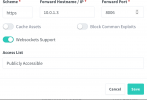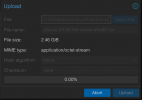This nailed it! Many Thanks!!!!!!This happened to me also,
I installed Nginx-Proxy-Manager, and I tried to log in remotely. I had the same issue; The issue was corrected in my case by enabling Websockets Support, and that solved my problem; now I can connect remotely, no more code 1006.
Undefined Code: 1006
- Thread starter Maetz
- Start date
You are using an out of date browser. It may not display this or other websites correctly.
You should upgrade or use an alternative browser.
You should upgrade or use an alternative browser.
Could someone please give some more information on how to accomplish that? Could I just follow https://www.nginx.com/blog/websocket-nginx/ using the examples given there? Nothing to change at the backend (Proxmox)?
Last edited:
GUI seams easy, but I've got a headless nginx LXC.
Some having hints how to accomplish that if you've only got terminal access via ssh?
Some having hints how to accomplish that if you've only got terminal access via ssh?
If you're having WebSockets issues while using Nginx Proxy Manager, try adding these to your location / in your custom configuration (or in the regular configuration if using regular nginx):
NGINX:
proxy_set_header Host $host;
proxy_set_header X-Real-IP $remote_addr;
proxy_set_header X-Forward-For $proxy_add_x_forwarded_for;
proxy_set_header Upgrade $http_upgrade;
proxy_http_version 1.1;
proxy_set_header Connection "upgrade";Thanks!!! after enabling Websockets it's working now! Greetings from ArgentinaThis happened to me also,
I installed Nginx-Proxy-Manager, and I tried to log in remotely. I had the same issue; The issue was corrected in my case by enabling Websockets Support, and that solved my problem; now I can connect remotely, no more code 1006.
I was having the exactly the same issue, and for me, the problem was that i was using a reverse proxy to have https access. i was using nginx running locally on another machine, once i turned back to accessing the server using the local ip address it worked again.failed waiting for client: timed out
TASK ERROR: command '/usr/bin/termproxy 5900 --path /nodes/pve --perm Sys.Console -- /bin/login -f root' failed: exit code 1
I fixed this on my mac by going into KeyChain Access --> Login keychain (Under default keychain) --> tab Certificates and then double click on the hostname of your proxmox box. Under Trust, select always trust.
If you on MacOS using Safari ( it is OK in Chrome 'cause Chrome uses its own certs container but Safari does use system one) — you need to add self-signed Proxmox (node) certificate to your KeyChain and put "Always trust" under the Trust section.
So I had to:
export self-signed cert of a proxmox node using Chrome into a .crt file,
then drag-n-drop it into KeyChain --> System,
then chose "Always trust" under the Trust section.
And I got it working! (console in web-interface for vm and ct)
I know this is very old sub and idk if it has been solved but, im using nginx via lxc and added the below to my /sites-available/ configs to enable websocket connections:I'm getting the same code 1006, and I'm also using Nginx-Proxy-Manager. But I'm fairly new, so can you please tell me how to enable the websocket support.
proxy_http_version 1.1;
proxy_set_header Upgrade $http_upgrade;
proxy_set_header Connection "upgrade";
my whole config for by backend servers:
server {
listen 443 ssl;
server_name <your-domain>.com;
ssl_certificate /etc/nginx/ssl/cloudflare_origin.pem;
ssl_certificate_key /etc/nginx/ssl/cloudflare_origin.key;
ssl_protocols TLSv1.2 TLSv1.3;
ssl_prefer_server_ciphers on;
location / {
proxy_pass <internal-server-ip-addr>:<port> ; # Use HTTPS to connect to the backend
proxy_ssl_verify off; # Skip SSL verification for self-signed certs
proxy_set_header Host $host;
proxy_set_header X-Real-IP $remote_addr;
proxy_set_header X-Forwarded-For $proxy_add_x_forwarded_for;
proxy_set_header X-Forwarded-Proto https;
proxy_http_version 1.1;
proxy_set_header Upgrade $http_upgrade;
proxy_set_header Connection "upgrade";
# Timeout settings for WebSocket
proxy_read_timeout 60s;
proxy_connect_timeout 60s;
proxy_send_timeout 60s;
}
}
server {
listen 80;
server_name <your-domain>.com;
return 301 https://$host$request_uri; # Redirect HTTP to HTTPS
Thank you. This solved my problem. I had just setup nginx and was configuring proxy host. After assigning proxy host and SSL certificate, it was no more working. Just had to enable Websockets Support and it started working.This happened to me also,
I installed Nginx-Proxy-Manager, and I tried to log in remotely. I had the same issue; The issue was corrected in my case by enabling Websockets Support, and that solved my problem; now I can connect remotely, no more code 1006.

The related code means that websocket its blocked , so check the way how you reach the panel , most common its proxy way that u need allowing websocket traffic.Every time im trying to open the Webconsole/Webshell to one of my VM's, I get the same error message:
For the Shells its:
Undefined Code: 1006
And for the Consoles its:
Failed to connect to server
You can look see them both in the screenshots I uploaded.
This is what I found in the logs:
failed waiting for client: timed out
TASK ERROR: command '/usr/bin/termproxy 5902 --path /vms/104 --perm VM.Console -- /usr/bin/dtach -A /var/run/dtach/vzctlconsole104 -r winch -z lxc-attach --clear-env -n 104' failed: exit code 1
This all started about a week ago. Before that everything was working just fine.
Im thankful for all answers!



